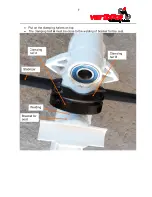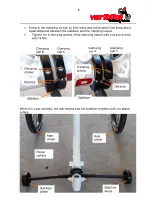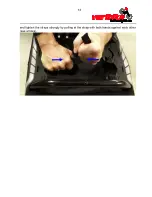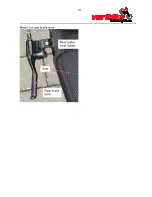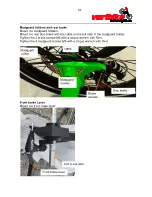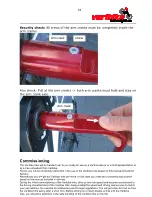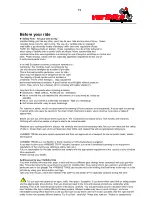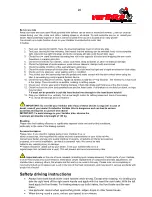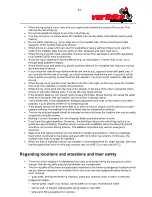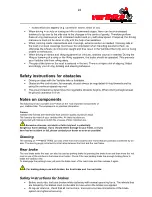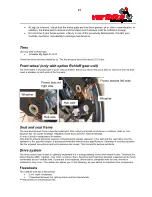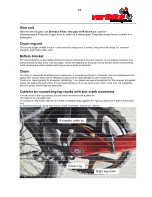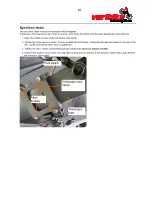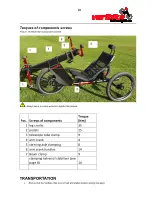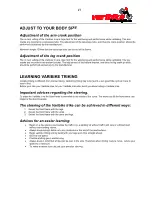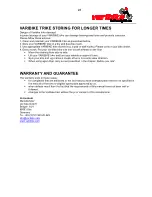
21
When driving round a curve, lean with your upper body towards the centre of the curve. This
reduces the risk of tipping.
Do not ride parallel to slopes to avoid the risk of tipping.
You may only drive on slopes where the Varibike trike can be safely controlled by steering and
braking.
Do not attach objects (e.g. carrier bags etc.) to the Varibike trike. These could prevent safe
operation of the Varibike trike while driving.
When driving on areas which are used for pedestrians keep a sufficient distance (at least the
width of the Varibike trike) from the kerbs or other obstacles and other road users.
When driving on public roads and paths, the provisions of the applicable road traffic regulations
(e.g German StVO) must be observed.
Avoid driving on unpaved or loose surfaces (e.g. on loose gravel, in sand, mud, snow, ice or
through deep puddles of water).
When travelling on bad paths (e.g. gravel, potholes) there is an increased risk of puncturing your
tyres and also of tipping.
If you encounter new driving situations which are new to you, approach them with great care. If
you consider that the risk is too high, you must immediately stop driving and, if required, call for
help to assist you getting yourself out from this situation. You must not do telephone calls while
driving.
When driving, never jerk the crank handles to the left or the right, as this may cause the Varibike
trike to tip over sideways in certain circumstances.
While driving, never grab onto the area of the wheels, in the area of the chain / sprockets /chain
wheels or into other rotating parts; if you do this may cause injuries.
If the situation allows it, you should carefully apply the brake. Abrupt braking can cause the upper
body to fall forwards, this can result in injuries or loss of driving control.
The Varibike trike is only designed for transporting persons and must not be used for any other
purpose, e.g. by playing children or to transport goods.
If the weight load on the drive wheel falls (e.g. when driving on slopes) or when driving on loose /
slippery surfaces, the braking force of the wheel may be considerably reduced.
The driving style and speed should be adjusted so that at all times the Varibike trike can be safely
stopped by using the brakes.
Braking in curves increases the risk of tipping. Better you brake before a curve.
If you have the option stabilizer: Be aware - the stabilizer reduces the risk of tipping but is no
guarantee against tipping. Therefore driving curves with a stabilizer wheel touching the ground
should be no common driving practice. The stabilizer should be only used in emergency
situations.
Make sure that cables and lines are not kinked or caught up somewhere. This could damage
them which could lead to the brakes and gear shift not functioning correctly. In this case, the
Varibike trike must no longer be operated.
When the trike is exposed to direct sun radiation or low temperatures for longer periods, take note
that the parts of the Varibike trike may become very hot (>40°C) or very cold (<0°C).
Regarding locations and situations and their safety
The driver of the Varibike trike determines the route to be driven taking the instructions of this
manual, their driving skills and physical abilities into consideration.
The driving skills of the driver are particularly important in the following dangerous locations which
are provided as examples; the Varibike trike's user must use their judgement before driving in
such locations:
•
quay walls, landing and berthing locations, paths and locations close to water, unsecured
bridges and dykes.
•
narrow paths, slopes (e.g. ramps), narrow paths on a slope, mountainous roads.
•
narrow and / or steeply sloping paths along roads or near cliffs.
•
ramps and lifting equipment on vehicles.

